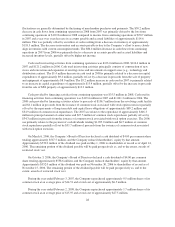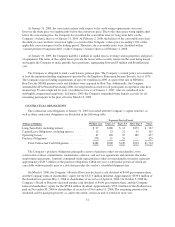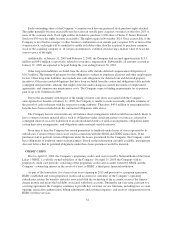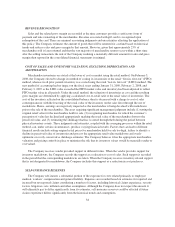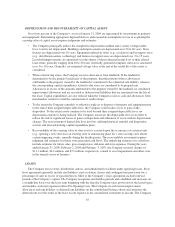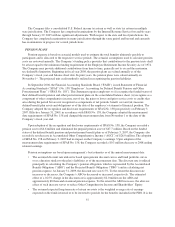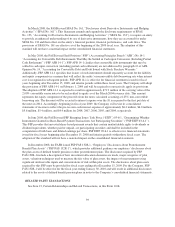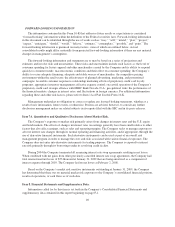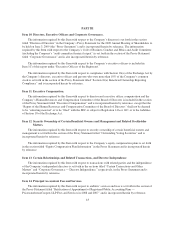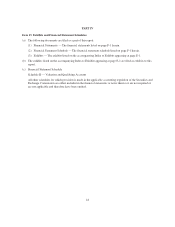Saks Fifth Avenue 2008 Annual Report Download - page 36
Download and view the complete annual report
Please find page 36 of the 2008 Saks Fifth Avenue annual report below. You can navigate through the pages in the report by either clicking on the pages listed below, or by using the keyword search tool below to find specific information within the annual report.DEPRECIATION AND RECOVERABILITY OF CAPITAL ASSETS
Over forty percent of the Company’s assets at January 31, 2009 are represented by investments in property
and equipment. Determining appropriate depreciable lives and reasonable assumptions for use in evaluating the
carrying value of capital assets requires judgments and estimates.
• The Company principally utilizes the straight-line depreciation method and a variety of depreciable
lives. Land is not depreciated. Buildings and improvements are depreciated over 20 to 40 years. Store
fixtures are depreciated over 10 years. Equipment utilized in stores (e.g., escalators) and in support areas
(e.g., distribution centers, technology) and fixtures in support areas are depreciated over 3 to 15 years.
Leasehold improvements are amortized over the shorter of their estimated useful lives or their related
lease terms, generally ranging from 10 to 20 years. Internally generated computer software is amortized
over 3 to 10 years. Generally, no estimated salvage value at the end of the useful life of the assets is
considered.
• When constructing stores, the Company receives allowances from landlords. If the landlord is
determined to be the primary beneficiary of the property, then the portion of those allowances
attributable to the property owned by the landlord is considered to be a deferred rent liability, whereas
the corresponding capital expenditures related to that store are considered to be prepaid rent.
Allowances in excess of the amounts attributable to the property owned by the landlord are considered
improvement allowances and are recorded as deferred rent liabilities that are amortized over the life of
the lease. Capital expenditures are also reduced when the Company receives cash and allowances from
merchandise vendors to fund the construction of vendor shops.
• To the extent the Company remodels or otherwise replaces or disposes of property and equipment prior
to the end of their assigned depreciable lives, the Company could realize a loss or gain on the
disposition. To the extent assets continue to be used beyond their assigned depreciable lives, no
depreciation expense is being realized. The Company reassesses the depreciable lives in an effort to
reduce the risk of significant losses or gains at disposition and utilization of assets with no depreciation
charges. The reassessment of depreciable lives involves utilizing historical remodel and disposition
activity and forward-looking capital expenditure plans.
• Recoverability of the carrying value of store assets is assessed upon the occurrence of certain events
(e.g., opening a new store near an existing store or announcing plans for a store closing) and, absent
certain triggering events, annually during the fourth quarter. The recoverability assessment requires
judgment and estimates for future store generated cash flows. The underlying estimates for cash flows
include estimates for future sales, gross margin rates, inflation and store expenses. During the years
ended January 31, 2009, February 2, 2008 and February 3, 2007, the Company incurred charges of
$11.1 million, $4.3 million, and $7.2 million, respectively, related to asset impairments and other costs
in the normal course of business.
LEASES
The Company leases stores, distribution centers, and administrative facilities under operating leases. Store
lease agreements generally include rent holidays, rent escalation clauses and contingent rent provisions for a
percentage of sales in excess of specified levels. Most of the Company’s lease agreements include renewal
periods at the Company’s option. The Company recognizes rent holiday periods and scheduled rent increases on
a straight-line basis over the lease term beginning with the date the Company takes possession of the leased space
and includes such rent expense in Store Pre-Opening Costs. The Company records tenant improvement
allowances and rent holidays as deferred rent liabilities on the consolidated balance sheets and amortizes the
deferred rent over the terms of the lease to rent expense in the consolidated statements of income. The Company
35





